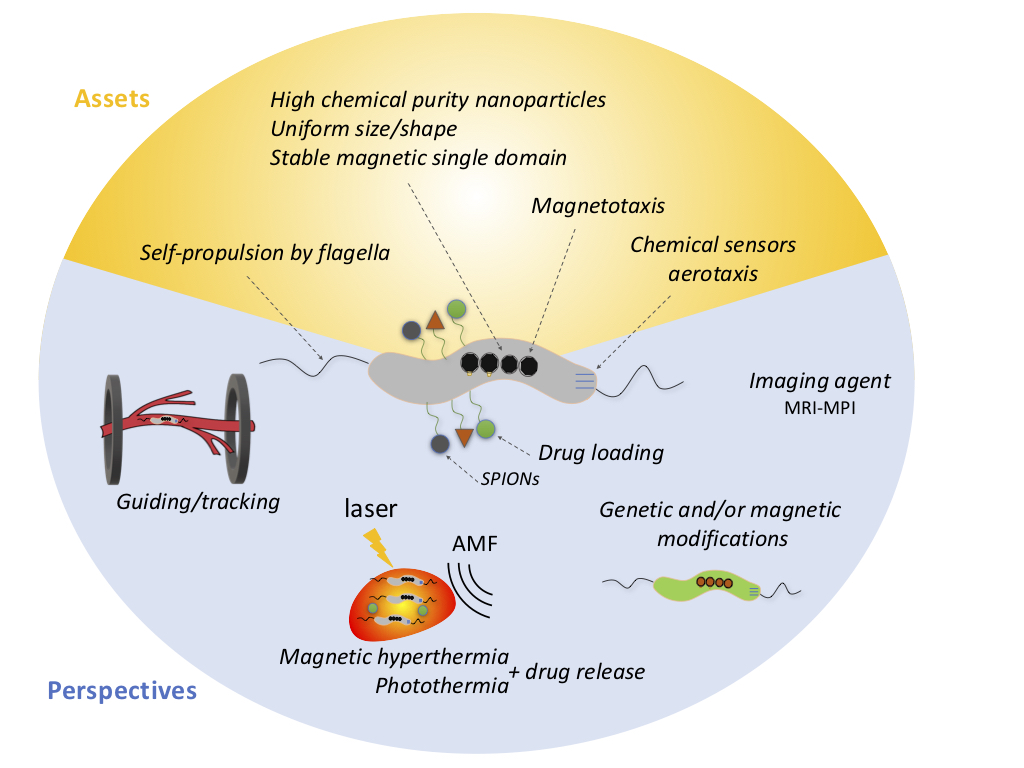
Magnetotactic bacteria as nanobiots for specific therapies against cancer (PID2020-115704RB-C3) : MINISTERIO DE ECONOMÍA Y COMPETITIVIDAD From: September 2021 to: September 2024 PI: M.L. Fernández-Gubieda
Cancer is one of the most common causes of death in the world with mortality rate higher than 50%. There is a need of finding novel cancer treatments more effective that substitute/complement the current ones. The new fighting strategies should overcome the known limitations inherent to standard treatments: unspecific targeting, heterogeneous distribution of drugs in the tumor area, and non-selective cytotoxicity. This coordinated project proposes to study the potential of Magnetotactic Bacteria (MTB) as an alternative approach for specific cancer therapies.
MTBs are aquatic microorganisms able to biomineralize membrane-enclosed magnetic nanoparticles and arranged them in a chain that allows the bacteria to align and navigate along the Earths magnetic field. MTB are promising agents for cancer treatment, taking advantage of their capabilities of self-propulsion, provided by the flagella, and guidance, ensured by the magnetic chain while retaining the therapeutic and imaging potential of the magnetic nanoparticles. MTB are envisaged as nanobiots that could be guided by external magnetic fields while are naturally attracted towards hypoxic zones, such as tumor regions, due to the microaerophilic character.
Subproject 1 at the UPV/EHU will be in charge of growing different bacterial species being the main goal to obtain multifunctional MTB by doping them with suitable rare earth or transition metal elements. This will allow us not only to tune the magnetic response of the MTB, but also to provide bacteria with additional properties such as fluorescence or improved MRI contrast. Moreover, aimed to optimize their therapeutic performance, liposome functionalized-MTB will be generated for cargo delivery. We will also analyze the biocompatibility of MTB, the mechanisms of internalization and degradation by the cells, and the efficacy as hyperthermia and drug delivery agents.
Subproject 3 at UC will be responsible of tuning MTB as proper agents in view of their macroscopic magnetic properties. A deep understanding of the structural and magnetic properties of the selected MTB will be analyzed and interpreted surveying the static and dynamic magnetic state, the core/shell configuration, and the arrangement of the magnetosomes within the MTB, in strong collaboration with Subproject 1. Selected benchmarking tests will be conducted with commercial samples provided by a SME company.
Subproject 2 at BCMaterials will be responsible for studying the motility and guidance of MTB in model systems with sensorized microfluidic channels. Combining experiments with numerical simulations they will aim to understand the features of the movement of bacteria and how to achieve a successful control guidance by means of magnetic fields. They will upgrade the magnetotaxis platform set- up in the previous project (MAT2017-83631-C3) by developing suitable microfluidic devices and integrating an hyperthermia system for in- situ treatment. Technological transfer may be envisaged if the performance of platform is optimized. Support for this shall come from the experience provided by another SME company. Feedback from all Subprojects is needed.
Finally, the three subprojects will be involved to test in situ the therapeutic capability of the nanobiots. To carry out the project a multidisciplinary team of researchers from materials science, physics, microbiology, electronic engineering and medicine have come together with a coherent objective.
Magnetotactic bacteria as sources of model magnetic nanoparticles and biorobots for targeted therapies (MAT2017-83631-C3-1-R) : MINISTERIO DE ECONOMÍA Y COMPETITIVIDADDuración, From: January 2018 to: September 2021
Coordinadora: M.L. Fernández-Gubieda
Summary:
Magnetotactic bacteria are aquatic microorganisms that swim along the Earth’s magnetic field lines towards low oxygen regions, using chains of nanoparticles biomineralized internally (called magnetosomes) as compass. The different species of magnetotactic bacteria synthesize perfectly stoichiometric magnetite nanocrystals, with genetically controlled sizes and shapes, surrounded by a biocompatible membrane, making them ideal for biomedical use. This project is oriented in two complementary directions: first, the thorough study of the magnetic properties of the magnetosomes and its relation with other nanoparticle systems, and second, the exploitation of magnetotactic bacteria for biomedical applications.
On the one hand, the high quality of magnetosomes makes them a perfect model system to investigate the relation between structure and magnetic properties, and to define experimental methods and characteristics for the appraisal of nanoparticle systems. This will be accomplished by comparing the magnetosomes to nanoparticles with distinct origin and properties, such as chemically produced magnetite nanoparticles and rare-earth based ones, obtained by mechanical alloying. The three systems will be studied using macro- and micro-characterization techniques, supported by analytical and modelling methods, in order to assess the influence of the structure, morphology and arrangement of the nanoparticles on their magnetic properties, and reproducibility. Intensive use of in-house and Large Scale Facilities techniques will be arranged.
On the other hand, we propose to employ the magnetosomes for cancer therapies based on magnetic hyperthermia and targeted drug delivery, using the previously acquired knowledge to optimize the final in-vitro tests. Additionally, this part of the project proposes a novel and more ambitious initiative, oriented towards exploiting the living bacteria as self-propelled biorobots for cancer treatment, using their tendency to navigate along definite magnetic directions and oxygen gradients. Ideally, guided inside the body by external magnetic fields towards hypoxic tumor regions, they can produce a therapeutic action both by releasing heat (hyperthermia) and therapeutic drugs (drug delivery). To test this approach, we will build a laboratory station composed of microfluidic channels mimicking human blood vessels in which the bacteria can be remotely controlled by using a magnetotaxis setup, while their position and movement will be tracked by a combination of microsized magnetic sensors and optical microscopy. The final drug and heat release will be activated by an incorporated magnetic hyperthermia system.
To carry out the project a multidisciplinary team of researchers from materials science, physics, microbiology, electronic engineering and medicine is gathered.
MAGNET-CELLPATCH H2020-MSCA-IF-2017. Marie Curie Felowship (Idoia Castellanos)Multimodal magnetic cellular-patches with synergistic effects for high performance theranostics
Entidad financiadota: European Comisión EU proposal 798830
Duración, desde: 2019 hasta:2021
Coordinadora: M.L. Fernández-Gubieda
